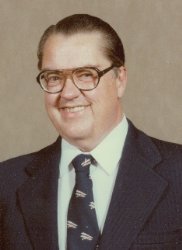-
(b.) - ?1925 September 23
Bio/Description
A 36-year veteran of the International Business Machines Corporation (IBM) he developed the Universal Product Code (UPC) in 1973. As an engineer at IBM he was asked to develop the pattern used for the Universal Product Code. Born in New York City, NY, he served in World War II and attended a technical school to learn radio and TV repair. Upon completion of his first year at the technical school, his instructor convinced him that he should not continue that course of study, but that he should go to college. He received his B.S. degree in Electrical Engineering from the University of Maryland in 1951. While at IBM, he had been instructed to design a code that could be printed on food labels and that would be compatible with the scanners then in development for supermarket checkout counters. He was told to model it on the bull?s-eye-shaped optical scanning code designed in the 1940?s by N. Joseph Woodland. But he saw a problem with the shape stating, ?When you run a circle through a high-speed press, there are parts that are going to get smeared,? he said, ?so I came up with my own code.? His system, a pattern of stripes, would be readable even if it was poorly printed. That pattern became the basis for the Universal Product Code, which was adopted by a consortium of grocery companies in 1973, when cashiers were still punching in all prices by hand. Within a decade, the U.P.C. and optical scanners brought supermarkets into the digital age. He received no royalties for this invention, and IBM did not patent it. During his career, IBM recognized and rewarded him for many technical innovations. He received the prestigious ?Raleigh, N.C. Inventor of the Year? award in 1976. In 1980 he was honored with IBM?s Corporate Technical Achievement award for his work on the Universal Product Code proposal that was issued in 1970 by McKinsey & Co. and Uniform Grocery Product Code Council, Inc. He retired from IBM in June 1987. He is the holder of 25 patents and is the author of 20 published Technical Disclosure Bulletins and the co-author with David Savir of "The Characteristics and Decodability of the Universal Product Code". IBM Systems Journal 14(1): 16-34 (1975). Some controversy ensued when it was reported that the Universal Product Code has bit patterns at the beginning, middle and end of the barcode called "guard bars". He is often asked about the resemblance of these guard bars to the coding of the numeral 6. Some people see the three sets of guard bars as encoding the number 666, which is considered to be a sign of evil. He addresses this on his website: ?Answer- Yes, they do RESEMBLE the code for a six. An even parity 6 is: 1 module wide black bar, 1 module wide white space, 1 module wide black bar, 4 module wide white space. There is nothing sinister about this nor does it have anything to do with the Bible's "mark of the beast" (The New Testament, The Revelation, Chapter 13, paragraph 18). It is simply a coincidence like the fact that my first, middle, and last name all have 6 letters. There is no connection with an international money code either.? Today, he lives in Wendell, North Carolina.
-
Date of Birth:
1925 September 23 -
Noted For:
Developer of the pattern used for the Universal Product Code (UPC) -
Category of Achievement:
-
More Info:


